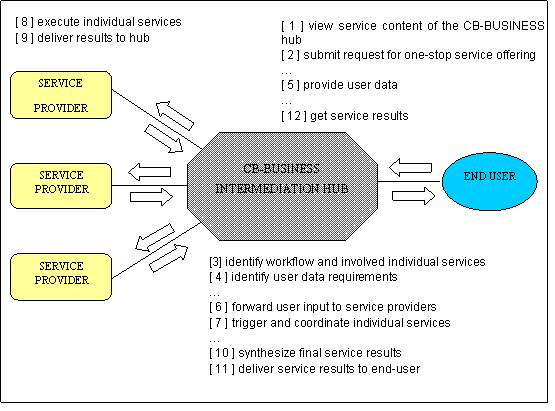April 2002–March 2004

#1. Project description
The overall objective of CB-BUSINESS was to develop, test and validate an intermediations cheme that integrates the services offered by government, national and regional administration agencies as well as commerce and industry chambers of EU and Enlargement Countries in the context of cross-border processes.

CB-BUSINESS specific objectives were to:
- Design a unified true “one-stop shop” service model for “Business-to-Government” interactions
- Single window for access to services and completion of transactions
- Functional integration of individual workflows of service providers
- Develop a *WWW-based intermediation hub * that implements this service model and will act as a pivotal point of contact for EU and enlargement country enterprises.
- Prove the* validity of the service model and pilot-test the WWW-based intermediation hub* in various specific cases that strengthen European integration and facilitate cross-border processes between EU-enterprises and businesses in enlargement countries.
The result of CB- BUSINESS project was an operational demonstrator comprising the technical infrastructure, application functionality and operational procedures necessary for:
- presenting service content, accepting requests and delivering results to end-users through a variety of communication channels.
- responding to end-user requests for service delivery by triggering cross-border administrative processes in a seamless manner.
- dynamically publishing new services, as the latter become available by participating service providers.

##CB-BUSINESS Operational Approach
Business enterprises face significant obstacles in their quest to interact with publicadministrations and governments across Europe.The most common problems include bureaucracy, ambiguous procedures, functionaldisintegration, vague and/or overlapping authority structures and informationfragmentation. All these problems get sharper when business enterprises enterinto cross-border processes and have to interact with foreign governments.
The CB-Business Hub was used as an intermediation portal for the following cross-border service offerings:
| No | CB-BUSINESS Services | Service Category |
|---|---|---|
| 1. | Info on Business Opportunities & partner search in one country |
Individual Informational Services |
| 2. | Info on market, economy & regulatory issues in one country |
|
| 3. | Info on companies and products in one country | |
| 4. | Info on fairs and exhibitions in one country | |
| 5. | Info on how to set up a company (foreign branch etc.) in one country | |
| 6. | Issuing Carnet ATA | Individual Transactional Services |
| 7. | Issuing Certificate of Origin | |
| 8. | Issuing Certificate of Existence | |
| 9. | Info on Business Opportunities & partner search in multiple countries | Combined Informational Services (informational + informational) |
| 10. | Info on market, economy & regulatory issues in multiple countries | |
| 11. | Info on companies and products in multiple countries | |
| 12. | Info on fairs and exhibitions in multiple countries | |
| 13. | Info on how to set up a company (foreign branch etc.) in multiple countries | |
| 14. | Setting up a company (for foreigners) | Combined Transactional Services (transactional + transactional) |
| 15. | Setting up a foreign branch | |
| 16. | Setting up a representation office | |
| 17. | Issuing Carnet ATA + Registration in ICIS | |
| 18. | Info on how to set up a company + setting up a company (for foreigners) |
Cross Services (informational + transactional) |
| 19. | Info on how to set up a company + setting up a foreign branch | |
| 20. | Info on how to set up a company + setting up a representation office | |
| 21. | Info on business Opportunities + Issuing Certificate of Existence |
These services were offered through the Cb-Business Hub according to the functional architecture presented below. In this proposed model, end userssubmit requests for one-stop service offerings, which are then decomposed bythe workflow management logic of the intermediation hub into individual service requests that are forwarded to the service providers; the latter return theirresponses back to the hub that manages the overall one-stop service workflow and finally returns results to the requesting end-users.
##CB-BUSINESS Technical Approach
The maintechnical result of the CB-BUSINESS project was the design and development of the intermediation hub that acts as a single point of reference for the endusers and handles all complexity of triggering and co-ordinating service provider workflows. Upon submission of a user request, the intermediation hub canidentify involved services, competent service providers and user inputrequirements and ask for the latter as appropriate. Upon provision of requiredinput data from end-users, the intermediation hub undertakes forwarding of userinput, triggering and co-ordination of process workflows of individual serviceproviders, rendering internal details regarding service execution procedures or workflows transparent for end-users; however, upon user demand, the processingstatus of end-users’ requests may be monitored and presented. Therefore, the CB-BUSINESS intermediation hub can employ overall workflows of cross-borderprocesses to trigger and co-ordinate individual service provider workflows,thus being able to deduce the progress status of user requests and report it asappropriate.
The technical architecture of the CB-BUSINESS intermediation hub is presented below.

Use of the CB-BUSINESS System
The CB-BUSINESS solution has been tested and used by the following government agencies:
- General Secretariat of Information Systems (GSIS), a public administration agency of the Greek Ministry of Finance (GMoF).
- Instituto Tecnologico de Canarias (ITC), a public organisation of the Government of Canarias that has been recognized as a fundamental agent in the setting in motion of actions intended to the approach of Canarias to the Information Society.
- Bulgarian Chamber of Commerce and Industry (BCCI), with 39000 associated members.
- Paris Chamber of Commerce and Industry (CCIP), representing the interests of 280000 companies located in Paris and its surrounding areas.
- Athens Chamber of Commerce and Industry (ACCI), representing the interests of 80000 companies.
- Chamber of Commerce and Industry of Romania and Bucharest (CCIRB), representing the interest of 23000 companies having over 1100000 employees, which represent about 25% of the Romanian
active labor force.
#3. Related publications
- Verginadis, G. and G. Mentzas (2004) ALight Modeling Framework for e-Government Service Workflows InternationalJournal of Electronic Government, Vol. 1, No. 4, pp. 420-438.
- Verginadis, Y., D. Gouscos, G. Mentzas (2004) Modeling e-Government Service Workflows through Recurring PatternsEGOV04: Third Egov Conference, DEXA Conference, Zaragoza,30 August – 3 September.
- Verginadis, G., D. Gouscos, M. Legal and G. Mentzas (2003) An Architecture for Integrating Heterogeneous AdministrativeServices into One-Stop e-Government Presented at the eChallenges 2003 Conference,Bologna, Italy, 22-24-October.
- Gouscos, D., M. Lambrou, G.N. Mentzas and P. Georgiadis (2003) A Methodological Approach for Defining One-Stop e-GovernmentService Offerings Presented at the EGOV03 Second Egov Conference, From E-Government to E-Governance,Prague (Czech Republic), September 1-5.
- Gouscos, D., Kalikakis, M., Legal, M., Papadopoulou, S., Verginadis,G. (2003) A performance and quality assessmentmodel for one-stop government-to-business e-services. Business Excellence Conference, Guimaraes, Portugal.
- Legal M., G. Mentzas, D. Gouscos and P. Georgiadis (2002) CB-BUSINESS: Cross-Border Business Intermediation throughElectronic Seamless Services Lecture Notes in Computer Science, Volume 2456,Issue , pp 338-343.
- Gouscos, D., G. Laskaridis, D. Lioulias, G. Mentzas and P.Georgiadis (2002)An Approach to Offering One-Stop e-Government Services Available Technologiesand Architectural Issues Lecture Notes in Computer Science, Volume 2456, Issue,pp 264-271

